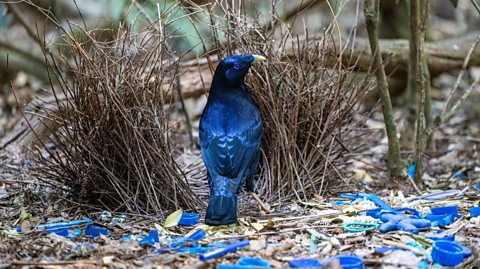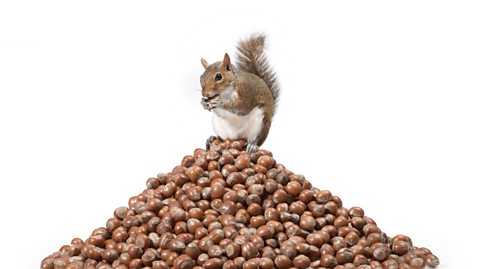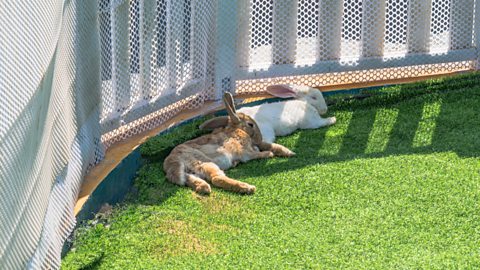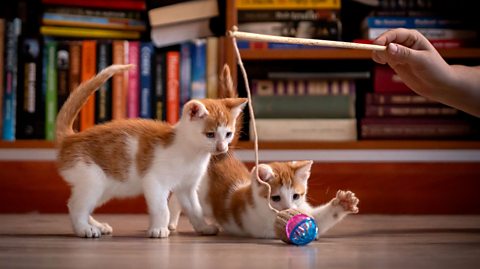When youÔÇÖre staying up with a mate putting the world to rights, do you ponder on what makes us human?
ItÔÇÖs easy to think human behaviour is exclusive when picking out a new wallpaper or challenging your friends to a gaming tournament - but that couldnÔÇÖt be further than the truth! Just as we have important roles in our ecosystems, animals have creature comforts not so different from our own. We take a look at five fun behaviours we share with animals.
Five fabulous behaviours animals share with humans

1. Decorating our rooms
There are many reasons to decorate your space. Maybe you like to show off your personality, or simply make your environment nice to stay in. Rearranging your room and decorating it with things you love can even put you in a better mood.
Lotus the rescue pig went viral in 2022 when she was shown picking flowers and plants to keep in her sty at a farm sanctuary in Georgia, USA. Lotus didnÔÇÖt eat the plants - her keepers think she just liked having them around for their smells, textures and colours. She was also observed taking plants with different properties - such as keeping flies away - to spots around the farm where she liked to nap.
This behaviour isnÔÇÖt exclusive to Lotus. The satin bowerbird of Australia loves the colour blue - theyÔÇÖve been shown to favour blue feathers from other birds, shells, flowers and even butterflies. They create horseshoe-shaped nests on the ground called ÔÇśbowersÔÇÖ and turn them into artworks as part of a courtship display in the hope that females will inspect them.
There are a few theories why satin bowerbirds favour blue: many birds can see in ultraviolet, which might be why this colour is attractive, or because itÔÇÖs similar to the plumage of the birds themselves. Unfortunately, as there arenÔÇÖt that many blue things in nature, bits of blue plastic from gardens and picnic tables have become easy pickings. Wildlife experts in Australia have urged people to be mindful when throwing rubbish out by cutting potentially harmful objects in half, such as blue rings from bottle tops, in order to keep the birds safe.

2. Collecting
When you think of animal collectors, you might think of magpies with their love for shiny things. But the thieving magpie could be a myth thatÔÇÖs circulated in folklore for centuries - a more recent theory is that magpies pick up things due to The fear of anything new or unfamiliar., and we only notice more when those things are precious. Unlike the satin bowerbird, thereÔÇÖs no real evidence that magpies enjoy shiny things and their nests are often found to be very sparse.
However many other animals like to grab things and hoard them. Hoarding is a behaviour linked to food storage ÔÇô for example, when squirrels ÔÇśsquirrelÔÇÖ away food for the winter. But the instinct extends beyond food: ferret-owners might have noticed how their pets nab blankets, keys and jewellery and put them in different hiding places. This is thought to be an offshoot of the hoarding instinct known as ÔÇśpilferingÔÇÖ. Pilfering is when animals take things from another ÔÇślarderÔÇÖ and add them to their ownÔÇŽ the same way the family biscuits might end up stashed next to your bed so you get a look-in.


3. Dissing
Be honest, have you ever shown off or wanted to poke fun at someone? ItÔÇÖs very normal - dissing your mates can be a fun and jokey way to bond, as long as you're not joking about something you know they would find hurtful.
But the sentiment behind pointing a finger and going ÔÇśha-haÔÇÖ isnÔÇÖt exclusive to humans. If you have pet rabbits, you might even witness an adorable kind of ÔÇśdissingÔÇÖ behaviour. For bunnies, feeling safe enough to flop on their sides is a big deal - theyÔÇÖre showing they feel secure around you and their environment. But in front of a rabbit they donÔÇÖt get along with, this has been observed to be a non-aggressive insult - like saying ÔÇśI feel so unthreatened by you, look how happy I am!ÔÇÖ. Animal communication is complex and varies from species to species, but animals such as chimpanzees, dolphins, and many birds and rodents have all been observed to have a sense of humour.

4. Playtime
Cats and dogs are not the only animals that love to play. Many animals engage in playfighting with parents and siblings when theyÔÇÖre young, which was once thought to help them practise their hunting skills for later life. However, thereÔÇÖs actually little evidence that cats who grow up with toys and lots of play are significantly better hunters than those that donÔÇÖt.
ItÔÇÖs more likely that playing is just fun! Animals and humans alike experience a dopamine rush when engaging in play. Any bird belonging to the crow family, including ravens, jackdaws and magpies. will ÔÇśsnowboardÔÇÖ down frozen roofs in winter, young elephants use embankments as water slides, and fish have been observed to ÔÇśchaseÔÇÖ each other - so itÔÇÖs thought that when animals are in a relaxed setting, they will voluntarily engage in repetitive play behaviours. But, like us, it depends highly on the individual: some animals will simply be more playful than others, and itÔÇÖs not an indicator of their intelligence.

5. Grooming
This one probably comes as no surprise - many animals enjoy being clean and pampered. In primates, grooming is a social behaviour as well as a hygienic one. And itÔÇÖs more complicated than just bonding: grooming can be used to make up after fights, diffuse tension and also establish each primateÔÇÖs place in the social hierarchy. This is known as ÔÇśallogroomingÔÇÖ.
And because mutual grooming was such an important evolutionary development for our speciesÔÇÖs survival, it might explain why people in general love their hair styled or their nails manicured today. But because we donÔÇÖt have fur, some anthropologists believe gossip and chitchat might be the modern human equivalent to allogrooming. This theory was developed in 1996 by evolutionary psychologist Robin Dunbar, and proposes that gossip (meaning talking about people and things that aren't present, not necessarily spreading rumours) serves a similar purpose in growing relationships with each other, establishing yourselves in a hierarchy among peers and exchanging social information.
This article was published in September 2023

How were our favourite animals domesticated? A brief history of pets
91╚╚▒Č Bitesize takes a look at how our favourite animals became pets over the years.

How would animals do at school?
Discover six wildlife wonders that might top the class at certain subjects.

ÔÇśDo I really sound like that?ÔÇÖ Why we cringe at hearing our own voices
Listening to a recording of our own voice can be interesting, to say the least. But why does this happen?
